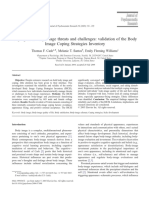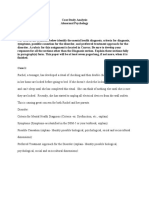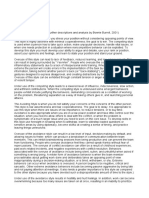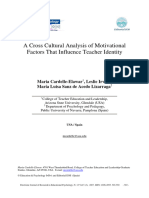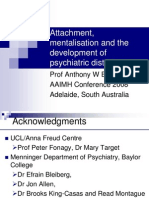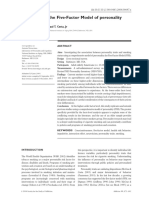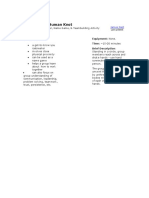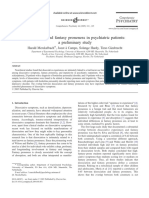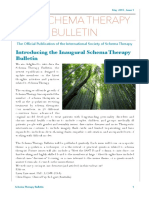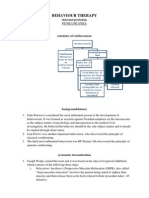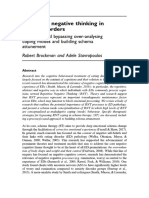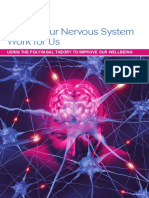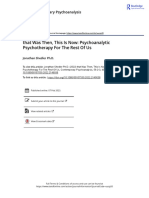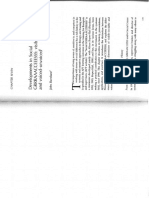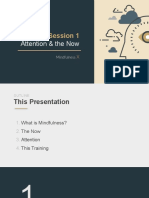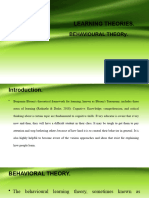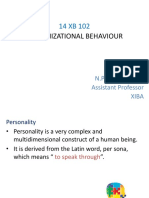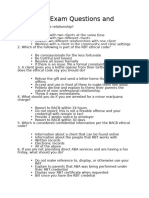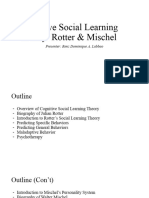ISST Bulettin June 2016
ISST Bulettin June 2016
Uploaded by
xx xxCopyright:
Available Formats
ISST Bulettin June 2016
ISST Bulettin June 2016
Uploaded by
xx xxCopyright
Available Formats
Share this document
Did you find this document useful?
Is this content inappropriate?
Copyright:
Available Formats
ISST Bulettin June 2016
ISST Bulettin June 2016
Uploaded by
xx xxCopyright:
Available Formats
Schema Therapy Bulletin June 2016 , Issue 4
THE SCHEMA THERAPY
BULLETIN
The Official Publication of the International Society of Schema Therapy
This issue- Experiential Elements in Schema Therapy
Schema Therapy relies on Cognitive,
Behavioral and Experiential Strategies as well
as Limited Reparenting. In this issue we are
pleased to highlight some new and creative
approaches to Experiential work.
Ofer Peled proposes eight different
presentations of dysfunctional parent modes,
and has a developed a hierarchy of
confrontational interventions to address each
presentation. Identifying both the the
characteristics and the intensity of each
dysfunctional parent mode, and understanding
the patients unmet needs enables therapists to
assume a stance in imagery or in mode work
using chairs that will be most effective in
helping patients get core needs met in a
healthy way.
Christof Loose works with children and
adolescents. His article describes a very
creative technique he uses with children, in
which he and the child identify the child’s
modes, and write them down. The child then
creates his own “mode sketch”, and assigns a
finger puppet to each mode. Through the
finger puppets the child is able to understand his modes, and work with them to find ways to get his
needs met.
Rita Yonan works extensively within a group schema therapy framework. She looks at novel
creative and experiential opportunities that are available within group schema therapy context. In
addition, she discusses how experiential and emotional components of therapeutic work can be
enhanced within a group format.
Chris Hayes is involved in research investigating the use of imagery respiting for childhood
trauma. His article discusses imagery re-scripting within schema therapy context, and looks at
Schema Therapy Bulletin 1
Schema Therapy Bulletin June 2016 , Issue 4
practical ways therapists can improve
In this October Issue
imagery techniques and skills.
Br uce Stevens and Pierre Cousineau
A Hierarchy of Confronta0onal contributed an article about Memory
Interven0ons Facing 8 Reconsolidation and the brains ability to
Dysfunc0onal Parent Modes unlearn or relearn at the level of Emotional
Ofer Peled (Israel) Learning. They describe recent findings
which may help to explain why imagery is
such a powerful intervention in Schema
Schema Therapy with Children
Therapy.
and Adolescents an Extract of
Mode Work As these innovative techniques
Christof Loose (Germany) demonstrate, Schema Therapy remains a
dynamic and evolving model. We look
forward to continue to share our members
Experiential Strategies in creativity with you in future issues.
Group Schema Therapy
Dr. Rita Younan (Australia) Editors,
Lissa Parsonnet, PhD., LCSW (USA) &
Memory Reconsolidation: Can C h r i s Ha y e s , C l i n i c a l Ps y c h o l o g i s t
we Unlearn Emotional Learning? (Australia)
Dr Bruce A. Stevens (Australia)
Dr Pierre Cousineau (Canada) A Hierarchy of
Confronta0onal
Imagery Rescripting, Practical Interven0ons Facing 8
ways to Improve Skills
Chris Hayes (Australia) Dysfunc0onal Parent
Modes
Ofer Peled, The Schema Therapy Center
Raanana, Israel, Bar-Ilan University
Young et al. (2003) refer to the critical punitive
and the demanding parent modes as negative
internalized representations of parents and
other significant figures. Since there are several
parental styles (e.g. Maccoby & Martin, 1983) it
is conceivable that there are much more
internalized dysfunctional parent modes than
the two suggested by Young.
Schema Therapy Bulletin 2
Schema Therapy Bulletin June 2016 , Issue 4
Young et al. (2003) instruct therapists to help patients battle and defeat their internalized
dysfunctional parent modes. Many patients and therapists find combating the parent voices
makes them needlessly critical and punitive themselves. The hierarchy of confrontational
interventions enables matching the intervention to the severity of the dysfunctional parent
mode. As with real parental coaching, when the parent-child relationship is not that
devastating, the hierarchy starts with empathic confrontation.
Empathic confrontation (Young et al., 2003) enables therapists to acknowledge the past
circumstances that led patients
develop their schemas and coping strategies (the empathic component), while pushing for
reality testing, distinguishing past from present and confronting the need for change (the
confrontational component). I would emphasize that the empathic component should
validate the core emotional
needs underlying the
schema; the confrontation
should address the
maladaptive coping
behavior. Validation makes
patients feel genuinely
understood by the
therapist and appreciate
their core emotional
needs and thus more
receptive to the
confrontational part which
helps patients change their
behavior to better realize
their needs in the preset
relationships.
Most parents mean good and try to balance between their children's needs and their own.
Validating this attempt allows patients to maintain their link to their formative support
structure (e.g. parent, family, community, culture) and meet the core emotional need for
connectedness. The confrontational component emphasizes the patients' right to move away
from the harmful aspects of the parent mode and seek for getting their emotional needs met
more appropriately. The therapist takes proportional action that moves from coaching (in the
mild level) to expelling the internalized parent mode (in the extreme level). The hierarchy
contains 3 levels of severity and 8 dysfunctional parent modes:
A.Distressing level (for mild degree of severity)
At this level it is quite easy to validate the internal parent's good intentions. Usually the
internalized parent lacks the knowledge and skills to appropriately and effectively meet the
Schema Therapy Bulletin 3
Schema Therapy Bulletin June 2016 , Issue 4
child needs. Education
about c h i l d r e n’s
developmental needs, and
coaching appropriate
attitude may prove
sufficient
1.The Naïve Parent Mode
C h a r a c t e r i s 0 c s : This
internalized parent is
immature, naïve, easil y
influenced by others, tends
to accept people and
circumstances as they are.
The therapist can This mode fails to teach right from wrong, anticipate
consequences, provide guidelines for handling everyday
validate the parent's life situations, and supply sense of safety.
acceptance of the Pa0ent's unmet needs: Protection, guidance, realistic
child and their limits
enthusiasm to spend Therapist stance: The therapist can validate the parent's
acceptance of the child and their enthusiasm to spend
time with the child, time with the child, as well as feeling puzzled when they
need to provide guidance to the child: "I can see how
as well as feeling happy you are to spend time with your child until it gets
puzzled when they more complicated and then you feel puzzled. Is there
someone with enough experience that you can consult
need to provide with? If there is no one I will be happy to guide you how
to meet your child developmental needs".
guidance to the child
2.The Anxious Parent Mode
Characteris0cs: This internalized parent is highly anxious, worries things will go wrong, and
overwhelmed with images of bad outcomes. This mode becomes over protective, intrusive,
and fails to let the child mode practice some sense of competence and separation.
Pa0ent's unmet needs: Autonomy, competence, sense of identity; spontaneity.
Therapist's stance: The therapist can validate the parent wish for an inner sense of safety
regarding the child, while understanding that the child must develop the ability to take good
care for him/her self. The therapist can instruct this mode to practice anxiety regulation
techniques and guide them to encourage self efficacy and resilience in the child by helping
them to take calculated risks and develop problem solving skills: "Of course you care for your
Schema Therapy Bulletin 4
Schema Therapy Bulletin June 2016 , Issue 4
child’s safety and yet you want him to become a self reliant adult with full ability to take good
care for himself. To achieve this precious goal we, the parents, need to contain our fears,
acknowledge them without acting upon them, and bit by bit free our child to experience life
and develop some sense of competence. I know that can be difficult. Will you try that for the
sake of your child?"
3. The Permissive Parent Mode
Characteris0cs: This internalized parent is more like a friend of the child. Usually holds a
stance that children have to fallow their inner inclination with minimum interruptions from
their environment. The parent tends to praise, admire and even aggrandize the child but sets
almost no standards of mature behavior, self regulation and discipline, expectations for
sustaining immediate gratification for the sake of long term achievements. This mode
resembles Baumrind's indulgent parenting style (Baumrind, 1967).
Pa0ent's unmet needs: Realistic limits and self control.
Therapist's stance: The therapist can validate the parent’s great joy in watching their child
develop authentically, while setting realistic limits: "it is great that you care for your child
authenticity in his relations with himself and with others; I can see how much you genuinely
love who he is, as he is. But every child needs to learn to regulate their affect and behaviors,
and develop the ability to tolerate frustration in order to achieve their long-term goals,
effectively communicate with others, and recognize and respect their own inclinations
without violating the feelings of others. Self regulation is developed through modeling and
teaching from care givers, who need to find a balance between “freedom” and realistic limits.
How do you think we can achieve this goal?”
B.Grave level (moderate degree of severity)
At this level it is more difficult to validate the internal parent's good intentions. Usually the
internalized parent blames the child for his/her own wishes, or pushes him/her to meet
unrelenting standards. The internalized parent lacks empathy for the child's emotions and
may become more argumentative or rigid when someone expresses disagreement with them.
At this level the therapist is more assertive in providing guidelines for the treatment of the
vulnerable child, and may need to set limits to protect the inner child.
4. The victim-like parent mode
Characteris0cs: This internalized parent believes that others are responsible for his/her bad
experiences; feels entitled and demands being taking care of; or uses his/her suffering to keep
others emotionally tied to him/her. This parent mode depends on the vulnerable child to feel
safe, belong and loved. When the vulnerable child tries to stand for his/her rights the
internalized victim-like parent mode turns to accusation, emotional or sick-role behaviors to
restore his/her grasp upon the vulnerable child.
Schema Therapy Bulletin 5
Schema Therapy Bulletin June 2016 , Issue 4
Pa0ent's unmet needs: Autonomy; freedom to express valid
ISST News
needs and emotions; authenticity, spontaneity and play.
Schema Therapy Therapist's stance: The therapist can acknowledge the
TV- internalized parent need for love and care while setting limits
Watch Alp and giving instructions allow the child to practice separation
Karaosmanoglu individuation according to the developmental tasks: "I can see
interviewing top how hard is for you to see your child grows to be separate
schema therapists- human being who may feel, think and wish differently from you.
these can be viewed at You might be sure it causes all the pain and trouble you have.
www.schematherapyso Your child cares for you but you need to take responsibility for
ciety.org/SchemaTV your own well being. I want you to free your child to discover
his own inclinations and I will be here to stop you whenever
you cross the line by tying your child too close to you".
2018 Conference
The conference
shortlist includes 5.The demanding and critical parent mode (Young et al., 2003)
Characteris0cs: This internalized mode sets unrelenting
- Washington DC, USA
expectations and standards in areas such as achievements, moral
- Perth, Australia behaviors, devotion, punctuality, perfectionism, efficiency,
pragmatism etc. This mode criticizes by means of verbal, tone
- Krakow, Poland
of voice, disapprove facial and body expressions and induces
- Honolulu, USA sense of guilt, shame and failure in the vulnerable child mode.
- Barcelona, Spain Pa0ent's unmet needs: acceptance, competency, spontaneity
and play.
The successful city will
be announced at the Therapist's stance: The therapist can acknowledge the inner
Vienna conference. parent best intentions for their child, but needs to confront the
criticism that crushes the inner child’s sense of worth,
competence, creativity and wellbeing: "I know you want the
best for your child but your criticism crushes your child potential to prosper. I want you to
stop criticizing and change your attitude by addressing your child needs for acceptance,
competency and creativity. You can start by giving praises, compliments, encouragement for
creativity, and embrace mistakes and difficulties."
C.Critical level (extreme degree of severity)
At this level little if any room is left for validating the internal parents’ intention. These
dysfunctional parent modes cause such profound harm that immediate action is needed to
stop and expel them in order to save the vulnerable child mode. Usually these parent modes
are internalizations of a very disturbed significant figure that is not capable of taking care of
Schema Therapy Bulletin 6
Schema Therapy Bulletin June 2016 , Issue 4
the inner child. The therapist needs to intervene immediately and engage other authorities
such as social services, police etc.
6. The neglecting parent mode
Characteris0cs: This internalized mode is aloof, disengaged, and practically neglects the
child's emotional basic needs and assumes little if any parental responsibility. This parent
mode is based on Maccoby & Martin (1983) neglectful parental style.
Pa0ent's unmet needs: The child’s emotional needs
are not met because the attachment figure is The therapist needs
emotionally absent.
to set limits and
Therapist's stance: The therapist needs to confront
the neglecting parent mode and engage healthier
provide psycho-
figures to take care for the vulnerable child. Usually education about a
healthy figure needs to step-in and some form of
internal foster care arrangement may be considered:
child’s emotional
"Your child needs to be taken care of by engaged needs for secure
person who will pay attention to the child's
emotions and supervise his behaviors. I want you to
attachment, stability,
be enga ged as much as you can but in the guidance
meanwhile Mr./Mrs. Y will be involved. Don't
sabotage this arrangement for the sack of your child. The social services will be involved to
help this arrangement work."
7. The chaotic parent mode
Characteris0cs: This internalized mode is unstable, unpredictable, disorganized, frantic, and
emotionally labile. This mode is so self absorbed in his/her own problems and has no capacity
to take into account another person, not even their own child. Living with this person is
frightening and paralyzing, and makes the vulnerable child mode constantly alert.
Pa0ent's unmet needs: No emotional needs are met, especially those for secure attachment,
realistic limits and self-control.
Therapist's stance: The therapist needs to set limits and provide psycho-education about a
child’s emotional needs for secure attachment, stability, guidance etc. The therapist limits or
minimizes the impact of the chaotic parent mode by engaging healthier figures (such as
relatives) to protect and nurture the vulnerable child mode. The social services may need to
arrange foster care: "I can see you have a lot on your mind and you are in a great need for help
which I'm willing to arrange for you. But right now we have to take good care for little
(child)’s need for stability and a sense of security. Mr./Mrs. Y (healthier relative) will take care
for little X (child). You may be in contact with your child under the supervision of Mr. Y.
Schema Therapy Bulletin 7
Schema Therapy Bulletin June 2016 , Issue 4
Youneed to put yourself together and take some professional help. The social services will be
Distressing
Parent Mode - Naive, Anxious & Permissive
Grave
Parent Mode - Victim Like, Demanding & Critical
Critical
Parent Mode - Neglecting, Chaotic, Abusive &
Punitive
part of this program to help you and protect little X".
8. The abusive and punitive parent mode
Characteris0cs: This internalized mode is the worst form of the dysfunctional parent modes.
Almost always this figure is severely mentally disturbed or suffers from severe personality
disorder and is not capable of parenthood. This internalized mode humiliates exploits,
intimidates, physically/sexually abuses and is very cruel toward the inner child. It is
unbearable to live next to this figure. This is an extreme version of Young's punitive parent
mode (Young et al., 2003).
Pa0ent's unmet needs: All the emotional needs are unmet but most of all the need for a
secure attachment.
Therapist's stance: The therapist needs to stop immediately the harm this abusive mode
causes and take the vulnerable child to a secure place. There is no other way than getting help
from the social services and the police in order to protect the little child. The therapist can
say: "I need you to stop right there what you are doing to little X (the name of the patient). It
is wrong and you are not allowed to do this. Obviously you have great troubles and you need
professional help that I can arrange. But right now little X cannot stay with you. The social
Schema Therapy Bulletin 8
Schema Therapy Bulletin June 2016 , Issue 4
services and the police are here to protect little X. If little X will need to see you it will be
only under supervision of the authorities.”
The confrontational hierarchy is a spectrum of interventions tailored according to the
internalized dysfunctional parent mode's severity. Matching intervention depends on three
axes and the interaction among them: 1. Reality axis – rate of severity and danger in actual
relationships; 2. Internalized relationships axis – rate of dysfunctional parent mode's severity
(distressing, grave, critical); 3. Therapy stage axis –
starting phase may require implied confrontation due
The hierarchy enables
to the fragile therapeutic alliance. Gradually the
the patients to
confrontation may become more explicit as the alliance differentiate
grows stronger. Eventually engaging the healthy adult themselves from the
mode is advisable as it become more prominent in dysfunctional aspects
therapy. These interventions, which blend validation of the parent mode
and confrontation, empower the healthy adult mode by and promote their
allowing the patients to rebalance between the need for separation-
connectedness and the need for being unique individuation process.
individuals who know how to take good care of
themselves. The hierarchy enables the patients to differentiate themselves from the
dysfunctional aspects of the parent mode and promote their separation-individuation
process.
Schema Therapy with Children and
Adolescents an Extract of Mode Work
Dr Christof Loose
Child and Adolescent Psychotherapist
Heinrich-Heine-University Dusseldorf
Institute of Experimental Psychology dept. Clinical Psychology
Let‘s imagine, there is a boy named Felix. His parents notice that something is wrong with
him. His teacher says that he tends to be aggressive. They decide that he needs some help.
They look for a therapist who can help Felix. Then, Felix gets to know Chris. He is a
Schema Therapy Bulletin 9
Schema Therapy Bulletin June 2016 , Issue 4
psychologist and therapist for children and adolescents. After Felix‘s parents have asked him
to help, he meets up with Felix. Chris encourages Felix to talk about himself and his world.
He is especially interested in all the different
sides of Felix that come out at different times.
He calls these different sides „parts“ or
„modes“. He asks him: Felix, I am really
interested in finding out about you, and about
all of your different sides, or „modes“ as I call
them. Which different sides of yourself have
you noticed? Let‘s write that down, okay?“
Felix creates his own mode-sketch.
Fig. 1. Felix‘ modes in a sketch
Once we have a picture of all of the different sides of Felix, he then chooses a finger puppet
for each mode.
Fig. 2 Felix shows how he rates
the popularity of his modes.
There is one thing that Felix
knows for sure: His favourite is
the contented mode. And he
smiled a lot when telling that.
And his least favourite is the
sensitive and vulnerable one. Felix looks sad now. But what about the others? Let‘s have a
closer look at them. “Modes, could you introduce yourselves, please?“
Hello! I go first, to get the least favourite over and done with: I‘m a part of Felix that many
people consider to be too sensitive. As you can see, I‘m already pretty scruffy. I don‘t like that
at all, because in fact, I want to be pretty and strong. However, in reality I‘m very, very
sensitive. A lot of people call me the „vulnerable or hypersensitive Felix“.
Hello from me as well! I am the contented, sometimes happy, part of Felix. I come out when
Felix feels good, and I look like joyfulness, giggling, and lots of fun and happiness.
Good day! I am another part of Felix. In fact, I am the clever & wise part. I know an answer
to everything, and know about Felix‘s needs or what might help him in difficult situations. I
usually look after him well, however sometimes I just don‘t know what to suggest to him.
Schema Therapy Bulletin 10
Schema Therapy Bulletin June 2016 , Issue 4
Hi! I am the „aggressive“ Felix. Nearly everyone shys away when I come out. I let Felix rage
and yell. This often results in some problems... But he feels proud because NO ONE else is as
powerful and strong as me.
Hey! I am the imaginative and fanciful part of Felix. When I am there, he is a fountain of
fantastic ideas. Well, the others are „louder“ than me for sure and try harder to get his
attention, but without me Felix would be SO BORED. And I help him with ideas to solve a
lot of his problems, too.
[quiet] Ohhh, I hardly dare to speak. But I‘ll try... Hello... I am Felix‘s anxious and scared
side. When I come out, Felix usually backs away. He feels insecure and sometimes he also
feels ashamed and almost completely loses confidence in himself.
Good day! I am the angry part of Felix, as you can tell from my facial expression. I often
come out when others are being unjust, unfair, or mean. I SIMPLY CANNOT STAND
PEOPLE BEHAVING LIKE THAT, ESPECIALLY TOWARDS FELIX.
After Felix has talked about his modes and assigned finger puppets to them, Chris comes into
play as a miniature figure. First, Chris turns to the scruffy, bedraggled, Raven, the vulnerable
Felix, and comforts him, soothing the pain from all the difficult, horrible, times he has
experienced. He provides the vulnerable Felix with a big patch and asks him, „what would
help you to feel better right now?“ „At last, someone is taking care of me, and noticing all my
pain and struggles!“, says the Raven, „First of all, I simply need your attention and comfort.“
The others don‘t even care about that!“ Chris sticks the patch on the Raven‘s upper body, like
a medal, as he replies, „I would very much like to give you my attention and comfort. I‘d also
like to help you get to know a bit more about your vulnerability and sensitivity, so I can help
you to understand more and even feel a bit better about yourself. Would that be okay with
you?“ And, as Felix nods his head, Chris begins to explain to him…
… that his "vulnerability" is actually a special gift. A superpower called the “Super Sensor”
that lets him feel what others are thinking and feeling, and also to notice if anything is wrong
or unjust. Chris presents Felix with an antenna labelled "Super Sensor" as a sign of this special
gift, this superpower.
The vulnerability or sensitivity, which many people have made out to be a bad thing, has now
become a (positive) sensitivity, a “Super-Sensor” superpower. This already sounds much better
to Felix. And because the “Super-Sensor" has done such a good job and reported all the
injustice that took place in the world, Chris gives him an award: The Golden Antenna! He is
really proud now!
Fig. 3 Chris presents Felix with "Super Sensor" antenna
However, Felix does not like to brag about things so he decides to take the award off the
antenna and place it out of sight. He knows about the award, others don’t need to see it, and
it is more important to him that the wounds are well protected. Therefore a bandage is
Schema Therapy Bulletin 11
Schema Therapy Bulletin June 2016 , Issue 4
placed over the patch so that
everyone remembers that he
has already been through a lot
of injustice (that’s why he looks
so scruffy) and – this part is
extremely important- that he
must be protected by others.
Now that the vulnerable and
sensitive part is protected,
Chris introduces himself to the
rest of the mode team. He
would like to get to know the
other parts better and asks a
couple of them to come to the
interview podium for a mode interview.
First of all, he learns from the aggressive Felix that he prevents Felix from feeling like a misfit
in class. He lets Felix roar and rage, in order to gain more respect from the others. Chris
thanks him for his openness and also for trying to gain respect for Felix. However he makes
clear that Felix will get into a lot of trouble, and that the respect is not so much respect as
fear, and because of the fear, many children will be too scared to get close to Felix. Then
Chris talks to the angry Felix, who made friends with the aggressive Felix in order to draw
attention to himself. Unlike his parents and teacher, Chris praises the presence of the angry
mode. In fact, feelings of anger are a natural reaction to injustice. These are at least partly
legitimate. But he also makes it clear that the legitimate anger should make friends with other
modes, otherwise Felix - if he only expresses his anger through the aggressive Felix - will
always be the one who gets into trouble. Then Chris turns his attention to the anxious and
scared Felix, who is scared of looking like a fool in front of the other children and becoming a
victim. Chris now focuses on reducing how often the anxious and scared part comes out,
while also helping angry Felix to make friends with, and receive support, from the other
modes.
Now Chris turns his attention to all the other modes and calls a mode council. It's like an
inner family meeting, where all the important things can be discussed openly and safely. The
mode council mainly discusses the vulnerable Felix who is "wounded" and in need of
protection, and certainly does not deserve to be laughed at or ignored. And it is discussed
that the vulnerable Felix has to be acknowledged as a “Super-Sensor", thus as a very
important source of information! Without him the other modes would have no idea what
kind of injustice is happening in the world out there, and that vulnerable Felix does not want
to be the weak and unpopular mode all the time. That's just not fair, because he is doing such
Schema Therapy Bulletin 12
Schema Therapy Bulletin June 2016 , Issue 4
an important job, and
doing it so well! And that
he needs everyone’s help
when he has something
to say.
Fig. 4: Mode Council
A basic rule is made:
T h e r e i s A LWAY S a
reason behind vulnerable
Felix appearing (i.e.,
when the big Felix is
hypersensitive, perhaps
in class). And in order to figure out the reason, he needs help, especially from the clever &
wise mode. The angry and anxious Felixes both add that they sometimes feel left alone, and
that is when they ask the aggressive Felix for "support“, because he will definitely do
something, unlike the others who don’t respond at all, or only just a little bit. But this
aggressive mode is really just an emergency mode, and needs to be kept only in case of an
absolute, complete, dire, catastrophic, emergency!!
The contented, imaginative and especially the clever & wise mode explain to the aggressive
mode that they are going to take more care of the vulnerable, fearful and angry modes, and
they apologize for having neglected the vulnerable, fearful and angry modes in the past. Then
all the modes come together, led by clever and contented modes, who celebrate the
importance of the vulnerable and sensitive mode. Everyone agrees that the raven can wear
the Golden Antenna with pride and celebrate his achievements! And after a long, long time
the vulnerable Felix finally feels that everything is okay with him. That he is not a pushover,
loser or hypersensitive person.
But he also understands now that he must learn to ask the others for help when he
experiences injustice in the world outside. Thus all the modes can come together as friends,
as a team led by the clever and wise mode, and all together can help to do something about
injustices.
Schema Therapy Bulletin 13
Schema Therapy Bulletin June 2016 , Issue 4
Experiential Strategies in Group Schema
Therapy
Schema Special
Dr. Rita Younan
Interest
Clinical Psychologist
Groups- get
ISST Advanced Certified Schema Therapy Trainer –
involved!
Supervisor
There are a number of
The Victoria Clinic, Melbourne Australia
Schema
Therapy Special interest
groups When I was asked to write this paper on “how to do
that meet regularly to experiential strategies in group” it got me thinking – what is
discuss different about implementing Schema Therapy experiential
interventions in a group versus individual? This is something
specific aspects of
I do day to day, (for the last four years in fact) as part of my
schema
role as the Program Director of a Group Schema Therapy
therapy. These include Program at a private psychiatric hospital in Melbourne,
- couples work Australia (The Victoria Clinic). Although GST is
- forensic work theoretically consistent with individual ST and most
- eating disorders individual interventions can be adapted to use in groups, a
- child and adolescent group does offer some additional creative opportunities.
GST strategically uses the therapeutic factors of the group
modality as described by Yalom. We also know from the
To be a part of these group
Farrell, Shaw & Webber (2009) rct and the published pilot
visit the ISST website.
done in the Netherlands (Dickhaut & Arntz, 2014) that a
group seems to catalyse the therapeutic effects of ST for
Research Blog patients with BPD. For this article, I discussed the issue
For recent developments with Joan Farrell and Ida Shaw, the developers of Group
in Schema Therapy Schema Therapy for Borderline Personality Disorder and
research see the new ISST the creative minds behind the imaginative ways in delivering
research blog- emotion focused techniques within the group setting.
www.schematherapysocie
ty.org/Research-Blog
The advantage of doing emotion focused work within a
group setting is that affect can be amplified by the presence
of more people in the therapy space. Similarly to individual
ST, emotional material can be explored and used as a
Schema Therapy Bulletin 14
Schema Therapy Bulletin June 2016 , Issue 4
learning tool for the
root experiences
associated with a
patient’s schema modes
with the advantage of
the opportunity for
group members to learn
from each other and
from others
experiences. Trauma
processing work, like
imager y re-scripting,
can be conducted in
groups as well and group
members can add a
different kind of support than therapists. Sometimes just observing other group members
doing emotion-focused techniques triggers emotional responses that reach the Vulnerable
Child mode of observing members. Vicarious learning is a group opportunity for patients
with avoidant features. In order to keep this brief I have focused on a few techniques that
give a snapshot of Experiential Strategies in GST. For a more detailed read please refer to
Group Schema Therapy for Borderline Personality Disorder, Farrell, J.M. & Shaw, I.A. (2012) and
Farrell, J.M., Reiss, N., & Shaw, I.A. The Schema Therapy Clinicians Guide: A complete Resource for
Building and Delivering Individual, Group and Integrated Schema Mode Treatment Programs.
Below are a few interventions that one could use within a group format as per Group Schema
Therapy (GST) with Borderline Personality Disorder (BPD) protocol by Farrell & Shaw
(1994).
The Art of Story Telling
Imagery work is a powerful experiential intervention used in Schema Therapy for healing the
Vulnerable Child Mode. In GST imagery change work or rescripting can be delivered in two
main ways: individual rescripting with group involvement and group as a whole rescripting.
Needless to say it is crucial to establish safety before doing any imagery work with patients
who present with a history of trauma and neglect. For patients with BPD connecting with
their Vulnerable Child Mode is usually met with negative and rejecting feelings. Therapeutic
stories of little children in situations where they have needs are often used to assist patients
in having compassion for a child’s emotional needs. This slowly paves the way for patients to
consider how helpless children can be and how dependent they are on a good parent to have
core needs met including feeling safe, secure and predictable. Through the story patients are
encouraged to think about what messages the child in the story would have taken from the
experience about her self-worth and the normality of needs being met by the adults in her
world. Patients are then encouraged to think about their Vulnerable Child and their needs in
Schema Therapy Bulletin 15
Schema Therapy Bulletin June 2016 , Issue 4
the same way to transfer compassion for stranger
children to themselves. Here’s an example: The advantage of
Alla & The Thunderstorm doing emotion
“A little child four years of age, woke from the focused work within a
crackling and banging sounds and loud rumblings of
a thunderclap that was so loud she felt like it was
group setting is that
shaking her bed. The noises were followed by affect can be
bright flashes of lightening that left behind scary amplified by the
images on her walls. At the very next thunderclap
she flew from her bed and ran to her parent’s room presence of more
feeling so frightened that all she could do was shake people in the therapy
and cry. Her crying turned into a scream at the next
sound of thunder. Her parent woke and started to space.
yell at her, stop crying they said: “It’s just a
thunderstorm, stop being such a big baby. Go back
to bed before you wake the entire household.” She went back to her room but couldn’t stop
crying. She bit down on her blanket so no sound would escape. She tried covering her ears so
she wouldn’t jump at the thunder, and she closed her eyes to stop seeing the scary arm that
were reaching out to grab her from the walls. She bit down harder and kept her eyes closed,
blocked her ears and kept repeating this over and over. After a while she didn’t jump
anymore, even though the thunder was louder, nor did she shake and duck when the creepy
arms tried to get her. She just sat there staring off into space.”
This story provides an example of the kind of situations in childhood where needs were not
met and schemas and modes develop. It does not need to be a situation of abuse, rather a
time when a child was left on his or her own to deal with intense feelings before he/she had
the resources to do so. In such situations a version of fight, flight or freeze will occur. One of
the most common child responses in the thunderstorm story is Detached Protector. Another
possible response would be Angry Child. The use of stories however, really encourages a
discussion around children and needs in a safe way for participants, and encourages self-
disclosure.
The importance of the happy-joyful child
The importance of spontaneity and play in child development has been well documented as
well as the importance of evoking and strengthening the Happy or Contented Child Mode
(summarized in Lockwood & Shaw, 2012). Play and creativity facilitate healthy emotional
development and provide the earliest learning about social interactions. In the case of
patients with BPD spontaneity and play were invariably not met, and not present in their
family environments. Through play when adult schema’s like Emotional Inhibition can be
Schema Therapy Bulletin 16
Schema Therapy Bulletin June 2016 , Issue 4
targeted as well as Mistrust/
Abuse and Social isolation/
alienation. Imagery involving
play can be a safe way to
initially engage patients who
have a strong Mistrust/Abuse
schema and/or are unable to
connect with their Vulnerable
Child Mode.
In GST Happy Child imagery is
often used to evoke, joyful
feelings and as a balance to the
difficult and painful work of
healing the VCM. An imagery
exercise that we use in group is
“the visit to the toy
shop” (Shaw, 2010). In this
image patients are encouraged
to get an image of their little
selves, with the other group
members standing at a bus
station waiting for a bus to
arrive to take them to a surprise
outing. The five senses are used as in traditional imagery to fully engage them in the
experience. Patients are instructed to notice what it feels like travelling in the bus, the view
from the window, the songs they sing together whilst they eagerly await arrival to designated
destination point. Once they arrive they are told that they can see out the window where we
have come to; a toy store so big that there are sooo many different toys in there that they are
going to be given time to search through the entire building. They are also told that the
group facilitator has won the lotto and they can buy ANYTHING they want from the toy
store. The participants are talked through the different aisles they encounter and can access.
Reference is made to their group peers and how they look, act and behave in the toy store.
The image is brought to life as much as possible. When the imagery exercise is complete,
patients open their eyes and are asked to describe their experience and what toys they
selected. As a facilitator whether you are the observing therapist or the one telling the story,
it is a delight to see the patients faces light up as they are truly involved and lost in the image,
some laugh out aloud, others are smiling, others have a concentrated look as they are trying
to locate that “right toy”.
The use of Happy Child Imagery is also a good way to deal with a group that is stuck or in
need of a shift in affect. This must be done with a significant amount of enthusiasm, and
Schema Therapy Bulletin 17
Schema Therapy Bulletin June 2016 , Issue 4
some therapists who
have their own
Emotional Inhibition
Schema may struggle
with this exercise. Ida
Shaw has a contagious
and exuberant way of
delivering this imagery;
in her training one can
really get lost too in the
joy of the exercise.
He a l t h y Ad u l t
Representation – Group
B a s e d Tr a n s i t i o n a l
Object
An unstable identitfile:///Users/chrishayes/Downloads/treey is a core symptom of patients
who present with BPD. Individuation and identity formation is the latter phase of the GST
process. The close analogue to the adolescent “peer group” these patients missed and,
provides a healing role in this unfinished stage of identity formation. An example of a
creative experiential group exercise that targets the Defectiveness/Shame schema found in
many BPD patients and to strengthen the Healthy Adult file:///Users/chrishayes/Downloads/
treeMode is the group multi-bead bracelet.
In a group session, therapists provide patients with a selection of inexpensive beads and
group members and therapists select a bead for each member that represents a personal
characteristic of him or her that they like or value. The “identity bracelet” for each person is
built by group members taking turns to presenting a bead and making a statement about what
it represents. This process continues until all patients have a completed bracelet. A
visualisation exercise follows in which patients are instructed to connect with the positive
feelings of receiving the bracelet in imagery while wearing the bracelet and putting their hand
over it. In this way the bracelet can be a physical anchor upon which to build a more stable
positive identity supported by their positive peer group. Beads can be added over the life of
the group to represent important experiences like a moment of belonging in their VCMs.
This activity is likened to the behaviour seen in adolescents who often trade pieces of
jewellery or clothes with best friends as part of bonding and identification process that
underlines identity formation. This emotional learning experience was usually one missed for
patients with BPD who grow up in invalidating or abusive childhood environments without a
sense of belonging to a healthy peer group or any group at all.
“The Group Army”- Fighting the Punitive/Demanding Critic Mode
Schema Therapy Bulletin 18
Schema Therapy Bulletin June 2016 , Issue 4
Imagery work in which the group and therapists become a
Recent Schema
“protective army” can be developed to support a patient in
Releases and
banishing their Punitive Parent. One powerful exercise is
Research
building a parent or critic figure out of cloth that patients
“Fine Tuning Imagery Re can draw in whatever way they want and then write their
scripting”. Remo Van Der critic messages on. This figure can be placed in a chair to
Wijngaart & Chris Hayes , 35 concretely represent their Critic Mode, lending reality to
video, 3DVD set focusing on mode dialogues and evoking strong emotions, including fear,
imagery rescripting anger and rejection. The parent “effigy” can be locked away
(available at
by the therapists to underline its powerlessness to do harm
www.schematherapytrainin
i n t h e p r e s e n t d a y. Jo a n Fa r r e l l h a s a f a v o u r i te
g.com
www.schematherapy.nl) demonstration of the power of the Punitive Parent being an
illusion. She holds the effigy up and compares it to the well-
Thiel, Nicola, et al. "Schema known movie character the Wizard of Oz. She suggests that
therapy augmented like the Wizard, the Punitive Parent is an illusion, a screen
exposure and response
that hides a powerless character. She holds the figure up to
prevention in patients with
full height and then lets it drop into a pile on the ground
obsessive–compulsive
disorder: Feasibility and stating, “like the Wizard, the Punitive Parent is all smoke
efficacy of a pilot study." and mirrors”. After completing this exercise, just like
Journal of behavior therapy experiential work in individual schema therapy, patients
and experimental psychiatry always comment on the power of the exercise, despite their
52 (2016): 59-67. preconceived ideas, and invariably turn to their fellow group
members and offer their appreciation of them joining the
Porter, R. J., et al. "No
change in fight against their Punitive Critic Mode.
neuropsychological
Imagery Rescripting- The power of the Group
dysfunction or emotional
processing during Healing the Vulnerable Child in Imagery can be done in a
treatment of major number of ways in GST: a) historical rescripting (e.g. trauma)
depression with cognitive–
b) using the cue for the group as a whole of a time when they
behaviour therapy or
needed a good parent c) Getting an Image of their VC and
schema therapy."
Psychological medicine hearing Good Parent messages spoken by the Therapist d)
46.02 (2016): 393-404. through story telling as previously described or e) through
the use of an Affect Bridge
Thiel, Nicola, et al. "Schema
therapy augmented Joan and Ida recommend that therapists set the stage for
exposure and response trauma rescripting in group by giving a demonstration in
prevention in patients with which the group with the second therapist rescript a
obsessive–compulsive medium level of difficulty memory of the other therapist.
disorder: Feasibility and
The approach is that the therapist tells about a memory as a
efficacy of a pilot study."
child of an experience in which a good parent is needed and
Journal of behavior therapy
and experimental psychiatry no one is there. After this the group discusses what the
52 (2016): 59-67. therapist as a child needed, what his/her feelings were and
Schema Therapy Bulletin 19
Schema Therapy Bulletin June 2016 , Issue 4
how the needs could be met. The rescript developed by the group members is checked out
with the therapist presenting the memory and additions or subtractions are made. The other
therapist then instructs the group with him/her to close their eyes connect with their VCM
and listen to what is said as a good parent to the therapist with the memory. They are told to
try to take in the positive reparenting messages and listen to the therapist’s tone. At the end
the group discusses how this went and the effects. The therapist sharing the memory
describes the new message she can take away from the rescripted experience. The group s
then asked who among them has a similar level of difficulty memory they would like the
group to rescript. Over time the group can also be involved in the implementation of the
rescripted memory. They may join a lonely child on the school playground or help rescue a
child from abusers. This use of selective self-disclosure from the therapist strongly facilitates
patients being willing to rescript their memories. It shows them that IMRS is not as scary as
they thought and that they do not need to re-experience trauma, rather stop before the
trauma actually happened and experience a rescue or what should have happened. The
therapist rescript also provides the corrective emotional experience of being treated as if they
have worth and value, i.e. they can contribute something to the therapist.
I’d like to thank Joan and Ida for their training, supervision and help in program development
in GST and their input for this tiny window into the wonders of delivering Experiential
Strategies in a Group Setting.
Memory Reconsolidation: Can we Unlearn Emotional
Learning?
Dr Bruce A. Stevens
Advanced Schema Therapist, Australia
Dr Pierre Cousineau,
Advanced Schema Therapist, Canada
In over 25 (Bruce) and 40 (Pierre) years of being therapists, we have sat for countless hours
with patients who have struggled with accepted ‘truths’ about themselves, beliefs that have
governed their lives, limited their choices and flooded their relationships with ugly emotions.
We have agonized with our patients in the slowness of the change process.
One of the most important questions in therapy is how can the brain unlearn something? Think
of one of your patients with early abuse or neglect. Or trauma. Or low self-esteem. Or
dysfunctional relational patterns. This is often the focus of therapeutic efforts and it is
frustrating how much the brain resists any change, even of early learning which is inherently
irrational and completely dysfunctional. And it can last a lifetime driving dysfunctional
patterns of behaviour.
Emotional Learning (EL) is something like a ‘bad tenant’. The person pays no rent and keeps
trashing your house. You want to evict them but nothing works. Even when you hand them a
Schema Therapy Bulletin 20
Schema Therapy Bulletin June 2016 , Issue 4
legal notice it is ignored. You bring
in the bailiffs but there is some
obscure law they can appeal.
Nothing works and the tenant
remains.
Martin believed “I am un-
loveable” from experiences of
neglect as a child. What he missed
out on continued and this belief
about himself became
consolidated. For many years it
was believed that once learnt, such
beliefs were indelible, ‘written’ in
the brain in a way that it could not
be erased (e.g., van der Kolk,
1994). Or that the process of
change was to learn new habits
over the old established patterns.
This has been called ‘counter-
active learning’ (Ticic, et al.,
2015). This is an attempt to
suppress the old learning and to
allow a different behaviour, but the
old remains and tries to resist. In
this view our brain (specifically
the limbic system) is a kind of
psychological prison.
We will call this approach ‘old therapy’, like Bruce’s children used to say ‘old school’, and
unfortunately most current therapies are counter-active. The counter-active techniques include
relaxation strategies superimposed on anxiety, new behaviours to overcome a sluggish lack of
motivation and thought blocking to oppose negative thinking. It is like trying to evict the
unwanted tenant by wearing down their resistance to leaving.
But what needs to happen to effect real and lasting change? Change must happen at the level of
Emotional Learning.
A Scientific Advance
Now some welcome news. There has been some remarkable, if somewhat obscure, research in
memory reconsolidation. Memory consolidation is when something is learned and later
strengthened; memory reconsolidation is when something new is learnt in place of what was
previously learned. Obviously both are central to the concept of Emotional Learning.
In the following discussion of theory and research I have cited some relevant studies so that
you can look at the neuroscientific evidence. It is hard to follow, but worth the effort.
Schema Therapy Bulletin 21
Schema Therapy Bulletin June 2016 , Issue 4
This memory research found that once an emotionally charged memory was formed, certain
later circumstances provide an opportunity for change (Pedreira, et al., 2002). The surprising
discovery was that the brain is able to wipe-out and change an established belief (Pedreira, et
al., 2004). This research was initially done with animals, such as the sand crabs used by
Pedreira, but it demonstrated an important neurological mechanism in which an animal can
unlearn something and re-learn it (Perez-Cuesta & Maldonado, 2009). The stimulus with the
sand crabs was of a predator (Pedreira, et al. 2004) which produced a trauma-like response –
which could be unlearned and safety re-learned. A similar mechanism has been found in
human memory research (Forcato, et al., 2007). The process of memory formation
(consolidation), retrieval and re-consolidation has now been well described and it would
appear that a number of different types of reactivation, such as waking reactivation (Walker et
al., 2003), can lead to reconsolidation (Alberini & LeDoux, 2013; also Lattal & Wood, 2013).
An interesting by product of this line of inquiry is how to match certain drugs to gain a similar
effect (discussed in Alberini & LeDoux, 2013). This could have important implications for the
practice of psychiatry. Nader & Einarsson (2010) have provided a useful review.
If you are interested in a thorough review of fundamental research in memory reconsolidation,
we recommend the textbook edited by Alberini ( Alberini, 2013). Also, Bruce Ecker (2015)
wrote an important paper on the specifics of memory reconsolidation process.
About Therapy
All this has revolutionary implications for therapy. Bruce Ecker has incorporated principles of
memory reconsolidation into his Coherence Therapy, the “reactivation of a well-consolidated,
longstanding implicit memory appeared to have rendered the stored emotional learning
susceptible to dissolution.” (Ecker, 2012, p. 18; also Ticic, et al., 2015). What came to be
appreciated was that a reactivation can de-consolidate a memory into a flexible state, which
was temporary and could be followed by a relocking or reconsolidation with new learning if
some mismatching information was present. The new ‘over-writes’ the old. Arntz mentioned
memory reconsolidation in his key note address at Istanbul, 2014.
New learning is supported by realization or direct perception. This gives an understanding of
the reasons why visualization techniques could be so efficient in Schema Therapy. We suspect
that memory reconsolidation, as a mechanism, operates not only in ST but in a range of
experimental therapies such as Coherence Therapy, EMDR, Emotion Focused Therapy, and
possibly psychoanalysis in its various forms. This is why such transformational therapies
‘work’, though not all practitioners are aware of the neuroscience mechanism of memory
reconsolidation.
At the risk of overstating a claim, memory reconsolidation is the ‘holy grail’ of psychotherapy.
Of course there will need to be future research to establish or contradict this explanation of
effective therapeutic change. But few would deny its considerable potential or applicability to
the most intransient of therapeutic problems.
Schema Therapy Bulletin 22
Schema Therapy Bulletin June 2016 , Issue 4
Now to some practical steps:
Miss-match
Reconsolidation is highly selective and affects only the memory that is being mismatched,
whatever that memory might be. This appears to be an inbuilt mechanism to allow flexibility
and change in learning. The change mechanism requires both:
(a) Reactivation, and
(b) Mismatch (an experience that mismatches the target memory or what EL expects).
This “prediction error” is
at odds with what is
expected. This is what
sets off a different mental
process which leads to
what is best described as
transformational change.
It replaces old learning.
Completely. There is
nothing to remain in
competition with the old
learning (Ticic, et al.,
2015).
Coherence Therapy has
identified juxtaposition of
the old and the new learning as elemental for change. A lot is claimed about the effects of such
an experience: New learning deletes old learning, is not subject to relapse, remaining symptom
free is effortless, and there is an increased sense of a unified self. We can also see juxtaposition
in chair-work and rescripting in ST.
Extended Case 1 Example of Sally (Bruce)
The following case is used with permission. I have found that the discovery of EL and
juxtaposition works well in therapy, though I would hasten to add that this was a dramatic
example of it working.
Sally is a senior military officer. She is highly respected in her field and had responsibility for
hundreds of soldiers in a training camp. She thought that her life was “travelling well. I had
what I thought was a loving husband, two teenage children and some very close friends. I also
had a range of people I knew through a family movie club I attended with my children.”
In a few months things deteriorated. Her husband announced he was leaving her. He had been
in an affair, which shocked her, and he went to live with his new partner. Sally survived all this
but about six months later her three closest friends, for a variety of reasons, ended their
friendship with her. One started to gossip about her at church, another moved to another city to
Schema Therapy Bulletin 23
Schema Therapy Bulletin June 2016 , Issue 4
pursue graduate studies and the last became over-involved in romantic relationship. The new
relationship took precedence and the girlfriend objected to his friendship with Sally.
All this devastated Sally. She became acutely suicidal and had to be admitted to a psychiatric
facility. She was seeing a counsellor who did some good work on Sally’s grief, but became
worried about the suicidal crisis. I saw Sally at that point and worked closely with her family
doctor and a psychiatrist who prescribed anti-depressant medication.
Over the next year I saw Sally more or less weekly. Some of my graduate students were also
involved in counselling support. She made great progress. She was able to return to her
military duties through a variety of psychological interventions including exposure therapy.
She seemed like she was almost fully recovered and we were thinking about completing
therapy. But then I thought about how intensely suicidal she had been. It was as if she held her
life ‘lightly’. Almost with no value. I worried that a similar crisis might occur in the future and
then she would be highly at risk of suicide. It had been a ‘close thing’.
So I used sentence completion about why she felt she had to kill herself. I had the sentence
completion “I need to kill myself because …” The result was very surprising:
“I am of value only to the degree I am helpful to others. If I need others, I become a
burden. My overall worth is the balance, if it is negative then I should kill myself to
restore the balance to zero.”
I wrote this on a card and she said that every word resonated as true for her. She was asked to
read the card once a day for the next week. A week later she reported a huge shift. She said that
the first sentence “I am of value only to the degree I am helpful to others” felt about 40% true
but the rest “not at all true” and was rated 0% true. She saw that previously her sense of self-
worth was extrinsic and was shifting to be intrinsic, and she felt “freer”. She revised her
emotional learning to the following statement, “I am a valuable person because I have my own
values which I can satisfy without needing affirmation from others. I can make a valuable
contribution without needing it recognized.”
I had Sally visualize saying this to a crowd that included her ex-husband, children, parents and
siblings. She had made some new supportive relationships and they were included as well. I
asked if anyone was missing and she said, “I want to see me there too.” She added, “I need to
hear myself say it.” I could see a profound shift and I was finally satisfied that the risk of
suicide was in the past. Her recovery from risk of suicide was as complete. Indeed I have seen
her in follow-up sessions since this turbulent period and while she has faced challenges, she is
emotionally stable.
Extended Case 2 Example of Martine (Pierre)
The following case is used with permission. Martine was already known to the therapist. The
reason for this new consultation was her ambivalence towards a love relationship and her
mother’s opposition to it (she disliked the boyfriend).
In one session, Martine expressed her wish to go out for a weekend with her boyfriend, but at
the same time was literally terrified to inform her mother about it. After this intense fear was
Schema Therapy Bulletin 24
Schema Therapy Bulletin June 2016 , Issue 4
clarified, the therapist asked her to close her eyes, visualize herself informing her mother,
focus on her somatic sensations while doing so, ending up by an affective bridge to past
experiences with such sensations (discovery work). The patient retrieved childhood memories
of physical assaults from her mother. This led us to the following formulation of a fundamental
emotional learning (punitive parent - abuse).
“Mom, when you’re angry at me, I’m afraid that you’ll grab me by the throat to kill me,
I’m terrified of dying. I become a little defenceless girl. That is what is triggered in me
whenever someone is angry with me or demands something from me.”
The daily reading of this emotional belief which was written on a card (integrative work)
triggered mismatching experiences (error detection under spontaneous mind processing). Two
situations confirmed an emotional memory modification: Martine didn’t experience fear when
she informed her mother of her plan of the weekend, and subsequently discarded her mother’s
objection to her personal decision. Martine was astonished that this was done without
extensive effort, a complete turnaround from her historical reactions.
But a few weeks later, Martine reported fear again while anticipating another situation. She
wanted to stop one of her voluntary work commitments. She had many such commitments and
had a hard time saying no to new solicitations (self-sacrifice schema) — this had led her to
burnout in the past. But the anticipation of saying to collaborators that she would conclude this
specific commitment triggered a fear anticipation. The intensity of this fear was close to terror
and it told us that our previous work left another memory track untouched. Metaphorically,
work with memory reconsolidation is like a laser beam intervention, you have to make sure
you are on the right memory track in order to modify it.
So, we extended our discovery work to this anticipated situation and ended up with the
following emotional belief, which added a subtle nuance to the previous one:
“Mom, you’re too strong for me. When you squeeze my arms, grab me by the throat and
threaten to kill me, I can’t do anything. If I try to defend myself, you will kill me.”
Spontaneously, Martine came out with a mismatching belief (another emotional belief—not a
cognitive disputation):
“Today, it is no longer true that I can’t do anything. I would be able to defend myself
and stop you from killing me.”
This second emotional belief referred to a situation in which, as an adult, she prevented her
mother from grabbing her by the throat. We then asked her to read alternatively both emotional
beliefs and check out how much they felt true to her (juxtaposition phase). She reported that
after a few days, the first one didn’t feel true to her anymore. Moreover, the fact that she didn’t
experience terror or fear with anticipation or actual announcement of her decision to end her
voluntary work with the group, confirmed the emotional memory modification. This was done
in just a few sessions and the new emotional belief maintained itself effortlessly.
Conclusion
Schema Therapy Bulletin 25
Schema Therapy Bulletin June 2016 , Issue 4
The quest to find what works in therapy has has drawn both of us to the edges of therapy. The
needs of our patients have kept us unsatisfied with our answers. Of course we have to
preference evidence based therapy, but we would never advance to new EBTs unless we are at
some level dissatisfied. So in this brief paper we have presented a process for therapeutic
change using memory reconsolidation from the neurosciences. There are a lot of edges but
thankfully we do not live on a ‘flat world’ so we will not fall off if we go there!
Imagery Rescripting: Practical Ways to
Improve Skills
Chris Hayes
Senior Clinical Psychologist, Accredited Schema Therapist
Sexual Assault Resource Centre, Department of Health, Western Australia
Director - Schema Therapy Training Australia
“How about we do some imagery
work today?”, I said to my client,
expecting a predictable imagery
rescript where I enter the image,
stick up and protect the child, and
provide the safety that they had
long been deprived. My supervisor
at the time had been encouraging
me to “do more experiential work”.
It had worked well in other clients
and I was up for the challenge.
“Close your eyes and get an image
of you as a child when you felt
unsafe”, I said to my client. My
client replied, “I’m walking into
my house, I’m about 5, and as I
walk in there are five big bikers
who are drunk sitting in my lounge
room…. I’m scared”.
Taken by surprise, I go through
the imagery process trying my best
to look calm and collected, but
secretly thinking….“WHAT ON
EARTH AM I GOING TO DO
Schema Therapy Bulletin 26
Schema Therapy Bulletin June 2016 , Issue 4
WITH FIVE BIKERS?!”. I looked around the room as if I was looking for an invisible
guiding colleague to appear!
In my mind I have an image of me saying: “Hello chaps…. I’m wondering if you can get out of
here, this child is afraid of you… I have a university degree you know!!”
Thankfully, over the years I’ve been able to continue to develop my skills using imagery
rescripting....
Imagery rescripting is a powerful experiential technique that uses the power of imagination
and visualisation to identify and change meaningful and traumatic experiences in the past,
resulting in transformation in the present. Typically those who are developing skills in schema
therapy specifically find imagery work an exciting, but often daunting clinical option.
Accessing corrective emotional experiences that a client has often never experienced (such as
XXXX) is often a powerful intervention. However, imagery rescripting is an intervention
often postponed or deferred in favour of more “safer” options.
In this article, I hope to provide five practical ideas to help fine tune and develop imagery
work within Schema Therapy.
1) Imagery Rescripting: “Messing with Meaning”
It is important to understand the theoretical underpinnings that may explain the process of
imagery work. At a schema level, Arntz (2015a) notes there are five main functions to the
imagery process, 1) the client has an opportunity to emotionally process emotions that
typically may not be easily accessed, 2) care, nurturance and support is provided to the client
in a way that was blocked as a child, 3) factors that have influenced how they feel about
themselves can be externally reattributed (e.g. “It’s not that I was a bad child, my parents had
serious limitations in their parenting,” 4) meaning is changed at a “child level” (one that is not
“rational” and logical), and 5) the client is able to understand that their environment growing
up was the exception and not the norm.
In terms of traumatic memories, from a cognitive-behavioural perspective, Arntz (2015b)
describes how imagery offers a chance to change the meaning of difficult memories through a
processing of “unconditioned stimuli revaluation.” Here, new information and perspectives
are made available via the client having their needs met via fantasy, resulting in a change of
the meaning of the memory to the client. The techniques here are not based on systematic
desensitisation principals, and as a result therapists should note that they don’t need to “play
through” the entirety of difficult, in some cases traumatic, events.
2) Increase Attunement in Float Backs to Assist with Better Links
Linking current triggering events to key childhood images can be accessed via a “float-back”
or “affect bridge” process. Here, the therapist asks the client to access a current triggering
image, identifies feelings and thoughts from this experience, and then links this back to a
childhood event with similar sentiments.
Schema Therapy Bulletin 27
Schema Therapy Bulletin June 2016 , Issue 4
Affect and meaning are the longitude and latitude for effective targeted float-backs. Clients
can often initially note that they feel “bad”, “overwhelmed”, and “not good”. Here the
therapist needs to increase attunement, and really “get” the experience, meaning, and themes
for the client.
If the therapist takes as face value the described “bad” feeling (“so hold on to that bad feeling
and get a bad feeling as a child”), clients can access a number of “bad” childhood experiences.
Greater attunement allows for clearer links to past events. For example, “So is that bad
feeling like you don’t matter, like you’re overlooked, and no one is interested?” “Hold on to
that feeling and the sense that you don’t matter and get a childhood image where you felt the
same”.
3) Accessing Specific Images & Memories
It’s difficult for anyone to specifically recall meaningful events from childhood, yet alone prize
open the memory vault to access memories linked to schemas and modes within a float back
context. One method is to use the “Google images” technique (De Jongh, Broeke & Meijer
(2010), often used in an Eye Movement Desensitisation & Reprocessing EMDR context.
Here, the therapist suggests to the client that they are making a memory “search” into their
mental “search engine” for a particular belief or schema, e.g. “I’m worthless, bad” (aka
defectiveness).
Similar to internet search engines, clients are encouraged to suggest several memories that
may be a part of their “search,” with the top “posting” most linked to the desired search. The
therapist may encourage the client to complete such a task in his or her own time as a
homework assignment, and use the exercise to “prime” the imagery work, or make links
throughout the session. Such key memories can then be used for future imagery work.
3) Winning the Exchange in Imagery
In imagery, the use of fantasy can be especially useful if the therapist feels unable to provide
the corrective emotional experience alone. In imagery, fantasy is limitless, so there is always
something that can assist with a successful rescript. However, therapists need to be attuned
to the client to determine if the intervention is meaningful and corrective. The client initially
needs to have some sense of safety, allowing clients to construct an image that allows for
safety (such as having a glass wall between the client and the antagonist, or having the client
as a child stand behind the antagonist).
In order to create a sense of empowerment and strength, protective devices such as Tasers,
Pepper Spray (Mace), or in some cases weapons could be used (particularly with violent
antagonists). The therapist can also manipulate the size and form of the therapist (make me
9-foot tall), or the antagonist (make him smaller in size and put him in a glass box).
4) Recollecting, Not Experiencing
Schema Therapy Bulletin 28
Schema Therapy Bulletin June 2016 , Issue 4
Clients can typically “recall” and retell events
from the past when discussing childhood
Imagery Rescripting- Themes
memories. However, it is important to help
and Responses
clients move from a “recollection” of an event
Empowerment to an “experience”. In some occasions it may
-“I am / we are running things be a way for a client to “distance” themselves
now.. not you”*
- “I’m not going to let you do from emotive aspects of a story (however
that….”* some clients may be more accustomed to
-“I’m not afraid of you…” “I can speaking in this way). In this case, the
handle you fine”* therapist can focus on sensory aspects, and
“You’re going to have to deal aim to assist the client to speak in a visual
with me now…”
and “present” way (preferably in first person,
present tense). For example, moving a
Safety
-“I’m here to protect you little X” sentiment from “she was a small girl scared of
-“I’m not going to let you harm dad yelling” to “I’m looking at dad yelling and
her anymore”* I’m scared.” Here the the client is able to
take the childhood experience and view the
Reattribution experience from the child perspective, rather
-“What is wrong with you?…
what you are doing/ saying is than a historical or adult one.
wrong”*
-“She doesn’t deserve this…”* 4) Key themes in Rescripting childhood
- “I know I am right….” “You’re trauma
the problem”*
- “What can a 5 year old do that’s Whilst not empirically validated, there are
that bad to be treated this way?” several key themes that are often observed in
rescripting childhood trauma images and
Care and Compassion managing antagonists.
“You’re very important/ visible
to me” (to child) Empowerment & guidance: Standing up
-“She/he needs you to hear them, to antagonists and providing emotional
take them seriously….” *
strength.
- “You need to show that you
care about your kids” * S a f e t y : Pr o v i d i n g p r o t e c t i o n f r o m
- “Every child needs to feel like antagonists.
they matter..”
Reattribution: Increase perspective and to
Validation and Grief place cause to external figures.
-“It’s understandable all kids
want to feel cared for” Compassion & Care: Providing nurturance,
-“Of course you want dad to be
care via limited reparenting.
nice to you”
Validation & Grief: Validating experiences
*(to antagonist)
and supporting sadness and grief, as a result
Figure 1
of not having childhood needs met.
Schema Therapy Bulletin 29
Schema Therapy Bulletin June 2016 , Issue 4
It’s important for the therapist to keep in mind what is the corrective emotional experience
required in the imagery scene. For example, a client that feels subjugated, dominated, and
disempowered in an image may initially need a sense of empowerment and safety. If the
therapist enters the image focusing on reattribution towards the antagonist (“What’s wrong
with you?, you’re the problem”), this may not provide the key ingredients for a corrective
experience. It may be pertinent for therapists to have in mind, “what does the client need?”
and “what is the corrective emotion experience that I’m trying to provide for the client?”.
Such awareness will act like a compass for rescripting work, resulting in attuned responses.
Often when tackling antagonists, it can be challenging for therapists to initiate effective
responses to both antagonists and clients. Figure 1, notes possible responses based on
rescripting themes.
5)The “Window of Tolerance” in Imagery
A number of theorists have previously discussed the use of the “Window of Tolerance” when
working with affect (Segal, 1999, Ogden 2006). Here, similar concepts apply to imagery-based
interventions. There is an optimal “window” of affective arousal that allows for effective
imagery rescripting and processing. If there is not enough emotional arousal (Hypo-aroused),
the client can present flat, detached, and disconnected from the visual material. Here the
therapist may need to focus on working on coping modes that are obstructing imagery work.
In addition, the therapist may need to increase sensory aspects to the rescript. One practical
tip here is to close your own eyes in imagery work. If you are unable to create an image, then
further sensory details may need to be sought.
In contrast, if the client is overwhelmed (or hyper-aroused), the therapist can help the client
to use the image itself to “down regulate” affect. For example, the therapist can ask for the
image to be “paused” or “to rewind,” or for the therapist to enter the scene (“I’m there with
you, can you see me, I’m here to protect you”). Hence using the imagery itself as an affect
regulation tool (rather than asking the client to open their eyes, etc.).
And so, back to our initial circumstance with the bikers and my client, what happened next….
I asked the frightened child client, “What do you need right now?”. She replied, “I need
someone to protect me and get these bikers out of my house.”
I entered the image, made myself larger, brought along a Taser, a can of pepper spray, and an
elite police team dressed in body amour and police dogs…
Despite my own imagined incapacity to “take on bikers” and protect the child, my client
noted, “this was the first time I ever felt someone could stand up to them….” A good result…
Fine Tuning Imagery Re scripting- a new DVD set from Remo Van Der Wijngaart and
Chris Hayes (available at www.schematherapytraining.com and www.schematherapy.nl)
Schema Therapy Bulletin 30
Schema Therapy Bulletin June 2016 , Issue 4
Announcement- 2016 International Society of Schema Therapy
ConferenceVienna, Austria
The ISST board is very pleased to announce the 2016 conference to be held in Vienna,
Austria on June 30 - July 2 2015 at the Messe Wien Exhibition & Congress Centre.
The conference will be the focal point of of schema therapy practice and research and
will host a number of key note speakers from around the world.
Details and registration details will be available soon at http://
www.schematherapysociety.org
Schema Therapy Bulletin- Upcoming Editions
In the next issue we will be bringing you then best from Vienna’s ISST conference!
References
A Hierarchy of Confrontational Interventions Facing 8 Dysfunctional Parent
Modes
Baumrind, D. (1967). Child care practices anteceding three patters of preschool behavior.
Genetic Psychology Monographs, 75, 43–88.
Maccoby, E. E., & Martin, J. A. (1983). Socialization in the context of the family: parent-
child interaction.In P.H. Mussen (Edt.) Handbook of Child Psychology : Formerly
Carmichael’s Manual of Child Psychology.. Retrieved from http://agris.fao.org/agris-
search/search.do?recordID=US201301452933
Young, J. E., Klosko, J. S., & Weishaar, M. E. (2003). Schema Therapy: A Practitioner’s
Guide. New York: The Guilford Press.
Experiential Strategies in Group Schema Therapy
Arntz, A. (2012). Group schema therapy for borderline personality disorder: A step-by-step
treatment manual with patient workbook. J. M. Farrell, & I. A. Shaw (Eds.). John Wiley &
Sons
Arntz, A. & Gendern Van, H. (2013). Schema Therapy for Borderline Personality Disorder.
Wiley – Blackwell.
Schema Therapy Bulletin 31
Schema Therapy Bulletin June 2016 , Issue 4
J. M. Farrell, & I. A. Shaw (2012). Group schema therapy for borderline personality disorder:
A step-by-step treatment manual with patient workbook. John Wiley & Sons
Farrell, J. M., Reiss, N., & Shaw, I. A. (2014). The Schema Therapy Clinician's Guide: A
Complete Resource for Building and Delivering Individual, Group and Integrated Schema
Mode Treatment Programs. John Wiley & Sons
Imagery Rescripting; Practical Ways to Improve Skills
Arntz, A. (2015a). Imagery Rescripting for Personality Disorders: Healing Early
Maladaptive Schemas. In Working with Emotion in Cognitive-Behavioral Therapy
Techniques for Clinical Practice Thomas, N. & McKay, D., Guildford, New York.
Arntz, A. (2015b). Imagery Rescripting for Posttraumatic Stress Disorder, In Working
with Emotion in Cognitive-Behavioral Therapy Techniques for Clinical Practice
Thomas, N. & McKay, D., Guildford, New York.
De Jongh, Ad, Erik ten Broeke, and Steven Meijer (2010). "Two method approach: A
case conceptualization model in the context of EMDR." Journal of EMDR Practice
and Research 4, 12-21.
Memory Reconsolidation: Can we Unlearn Emotional Learning?
Alberini, C. M. (2013). Memory Reconsolidation. London, UK: Academic Press.
Alberini, C. M. & LeDoux, J. E. (2013). Memory reconsolidation. Current Biology, 23(17),
R746-R750.
Ecker, B. (2015). Memory Reconsolidation Understood and Misunderstood. International
Journal of Neuropsychotherapy, 3 (1), 2-46.
Ecker, B., Ticic, R., & Hulley, L. (2013) Unlocking the emotional brain: Eliminating symptoms
at their roots using memory reconsolidation. New York: Routledge.
Forcato, C., Burgos, V., Argibay, P., Molina, V., Pedreira, M. & Maldonado, H. (2007).
Reconsolidation of declarative memory in humans. Learning and Memory, 14, 295-303.
Lattal, K. M., & Wood, M. A. (2013). Epigenetics and persistent memory: Implications for
reconsolidation and silent extinction beyond zero. Nature Neuroscience 16(2), 124-129.
Nader, K. & Emerson, E. (2010). Memory reconsolidation: An update. Annals of the New York
Academy of Sciences, 1191, 27-41.
Perez-Cuesta, L. & Maldonado, H. (2009). Memory reconsolidation and extinction in the crab:
Mutual exclusion or coexistence? Learning and Memory, 16, 714-721.
Schema Therapy Bulletin 32
Schema Therapy Bulletin June 2016 , Issue 4
Pedreira, M. Perez-Cuesta, L. & Maldonado, H. (2004) Mismatch between what is expected
and what actually occurs triggers memory reconsolidation or extinction. Learning and
Memory, 11, 579-585.
Stevens, B. (2016) Emotional Learning: The way we are wired for intimacy. Ebook available
through Amazon.com, Kindle and ibook.
Stevens, B. & Roediger, E. (in press, 2016) Breaking negative relationship patterns, Wiley
Publishers.
Ticic, R., Kushner, E., & Ecker, B. (2015). What’s really going on here? How to navigate life
using the hidden intelligence of our emotional brain. On line publication by Coherence
Psychology Institute.
Van der Kolk, B. (1994). The body keeps the score: Memory and the evolving psychobiology
of post-traumatic stress. Harvard Review of Psychiatry, 1(5), 253-265.
Young, J. E., Klosko, J. S., & Weishaar, M. E. (2003). Schema Therapy. A practitioner’s guide.
New York: The Guilford Press.
Schema Therapy Bulletin 33
You might also like
- Mentalization-Based Treatment For Adolescents - A Practical - Trudie Rossouw, Maria Wiwe, Ioanna Vrouva - 1, 2021 - Routledge - 9780367341015 - Anna's ArchiveDocument221 pagesMentalization-Based Treatment For Adolescents - A Practical - Trudie Rossouw, Maria Wiwe, Ioanna Vrouva - 1, 2021 - Routledge - 9780367341015 - Anna's ArchiveCesar BermudezNo ratings yet
- Family Process - 2022 - Doherty - Relationship Undermining Statements by Psychotherapists With Clients Who Present WithDocument13 pagesFamily Process - 2022 - Doherty - Relationship Undermining Statements by Psychotherapists With Clients Who Present WithCarlosNo ratings yet
- Cash2005 Coping With Body-Image Threats and Challenges Validation of The Body Image Coping Strategies InventoryDocument9 pagesCash2005 Coping With Body-Image Threats and Challenges Validation of The Body Image Coping Strategies InventoryMoon StarrNo ratings yet
- Argelander Initial InterviewDocument13 pagesArgelander Initial InterviewTiborNo ratings yet
- Defense MechanismsDocument21 pagesDefense MechanismsJolinaBanawaNo ratings yet
- Case Study AnalysisDocument4 pagesCase Study Analysisapi-656182395No ratings yet
- Relations Between The Functions of Autobiographical Memory and Psychological WellbeingDocument12 pagesRelations Between The Functions of Autobiographical Memory and Psychological WellbeingJasonNo ratings yet
- Helping Children Cope With GriefDocument2 pagesHelping Children Cope With GriefvijayNo ratings yet
- 5 Conflict Management StylesDocument2 pages5 Conflict Management StylesVincent JNo ratings yet
- Farell GroupSchemaTherapyDocument75 pagesFarell GroupSchemaTherapyParaskevas Alexis100% (2)
- Hunger for Understanding: A Workbook for helping young people to understand and overcome anorexia nervosaFrom EverandHunger for Understanding: A Workbook for helping young people to understand and overcome anorexia nervosaRating: 4 out of 5 stars4/5 (1)
- Schema Therapy Bulletin March 2016Document28 pagesSchema Therapy Bulletin March 2016diablero999No ratings yet
- Comorbidity of Body Dysmorphic Disorder and EDDocument10 pagesComorbidity of Body Dysmorphic Disorder and EDBookcessories FblNo ratings yet
- Affective Temperaments and SH in Adolescents - PortugalDocument8 pagesAffective Temperaments and SH in Adolescents - Portugalsoliveira_149796No ratings yet
- Self-Management Workbook 7Document4 pagesSelf-Management Workbook 7Jehanzeb ThakurNo ratings yet
- Pedagogy IndentityDocument28 pagesPedagogy IndentityMolnár RichárdNo ratings yet
- Vangeelen2015 PDFDocument8 pagesVangeelen2015 PDFHafizah Khairi DafnazNo ratings yet
- CH 5 Psychointetherap 2Document17 pagesCH 5 Psychointetherap 2Elif AktaşNo ratings yet
- 2015 Master of Narrative Therapy and Community WorkDocument4 pages2015 Master of Narrative Therapy and Community WorkAndi KurniadiNo ratings yet
- Sex Differences in Perceptions of Desirable Body ShapeDocument4 pagesSex Differences in Perceptions of Desirable Body Shapetorrid64No ratings yet
- The Application of Attachment Theory and Family SyDocument8 pagesThe Application of Attachment Theory and Family SySuresh LukoseNo ratings yet
- Issues in Group TherapyDocument23 pagesIssues in Group TherapyOlivia S. AgustinNo ratings yet
- Protagonist: Strengths & WeaknessesDocument7 pagesProtagonist: Strengths & WeaknessestestNo ratings yet
- Adelaide Attachment Mentalising Dec08Document55 pagesAdelaide Attachment Mentalising Dec08ssanagavNo ratings yet
- The Library of Object Relations David E. Scharff, Jill Scharff - Object Relations IndividualDocument654 pagesThe Library of Object Relations David E. Scharff, Jill Scharff - Object Relations Individualanahitapande7No ratings yet
- Relax Like A CatDocument16 pagesRelax Like A CatAmalia MarinescuNo ratings yet
- Disorder-Specific Psychodrama Therapy in Theory and PracticeDocument582 pagesDisorder-Specific Psychodrama Therapy in Theory and Practiceaulia AlmardiyahNo ratings yet
- Edwards - Using Schemas and Schema Modes As A Basis For (POR EMPEZAR EL PROCESO de TRADUCCION)Document14 pagesEdwards - Using Schemas and Schema Modes As A Basis For (POR EMPEZAR EL PROCESO de TRADUCCION)MateoNo ratings yet
- Treating Anxiety With MindfulnessDocument15 pagesTreating Anxiety With MindfulnessLeighton Frank AggNo ratings yet
- Depression, Existential FamilyDocument15 pagesDepression, Existential FamilyDorina LaçiNo ratings yet
- Group Imago and Dreamwork in Group Therapy: Anna Emanuela TangoloDocument12 pagesGroup Imago and Dreamwork in Group Therapy: Anna Emanuela TangoloВасилий МанзарNo ratings yet
- Smoking and The Five-Factor Model of Personality: Antonio Terracciano & Paul T. Costa, JRDocument10 pagesSmoking and The Five-Factor Model of Personality: Antonio Terracciano & Paul T. Costa, JRΕλενη ΜιχαντασηNo ratings yet
- Principles of Transactional Analysis - by Eric BerneDocument8 pagesPrinciples of Transactional Analysis - by Eric Bernecornelpc100% (1)
- The Psychology of Conflict - Mediating in A Diverse WorldDocument220 pagesThe Psychology of Conflict - Mediating in A Diverse WorldMafalda MadureiraNo ratings yet
- The Future of Online Therapy PDFDocument8 pagesThe Future of Online Therapy PDFAndre MelloNo ratings yet
- Group Therapy ExercisesDocument9 pagesGroup Therapy ExercisesChristine Juliani Shaheen BallNo ratings yet
- Personality TraitsDocument12 pagesPersonality TraitsjhumliNo ratings yet
- Mindfulness and Rumination. Does Mindfulness Training Lead To Reductions in The Ruminative Thinking Associated With DepressionDocument7 pagesMindfulness and Rumination. Does Mindfulness Training Lead To Reductions in The Ruminative Thinking Associated With DepressionJacqueline Karen Serra UndurragaNo ratings yet
- JST Chang & NylundDocument18 pagesJST Chang & Nylundab yaNo ratings yet
- Robert CloningerDocument9 pagesRobert CloningeralexvfcNo ratings yet
- 1950 - The Concept of An Ideal Therapeutic Relationship. - FiedlerDocument7 pages1950 - The Concept of An Ideal Therapeutic Relationship. - FiedlerFabian MaeroNo ratings yet
- Chidhood Grief and CounsellingDocument13 pagesChidhood Grief and CounsellingFatima RehanNo ratings yet
- Edward Weng Lok CHAN, Huey Jing Renee TAN: Case ReportDocument9 pagesEdward Weng Lok CHAN, Huey Jing Renee TAN: Case ReportFred ClementinoNo ratings yet
- RJ-Kappa 2Document75 pagesRJ-Kappa 2swamysantoshkumarNo ratings yet
- Dissociation and Fantasy Proneness in Psychiatric Patients: A Preliminary StudyDocument5 pagesDissociation and Fantasy Proneness in Psychiatric Patients: A Preliminary StudyKami0% (1)
- Solution Focused TherapyDocument7 pagesSolution Focused TherapyAditi KirtaneNo ratings yet
- Murray BowenDocument3 pagesMurray BowenKristine Hans Sepina100% (1)
- Early Recollections and School CounselingDocument37 pagesEarly Recollections and School CounselingPaul ThompsonNo ratings yet
- ISST May 2015 Schema Therapy BulletinDocument18 pagesISST May 2015 Schema Therapy Bulletinxx xxNo ratings yet
- Das SF PDFDocument14 pagesDas SF PDFrizuiNo ratings yet
- Family System TheoryDocument23 pagesFamily System TheoryZaiden John RoquioNo ratings yet
- Career Anchors Inventory QuestionsDocument4 pagesCareer Anchors Inventory QuestionsgopalkrizNo ratings yet
- CASE Formulation and TreatmentDocument38 pagesCASE Formulation and TreatmentSimona Moscu100% (1)
- Behaviour Therapy NotesDocument2 pagesBehaviour Therapy NotesPrathamanantaNo ratings yet
- Art Therapy For A Peaceful Mind: Maren Shallman Sophie Johnson Jourdann UtkeDocument9 pagesArt Therapy For A Peaceful Mind: Maren Shallman Sophie Johnson Jourdann Utkenwgnchameleon0% (1)
- Grief and Be Re Av Ment TheoriesDocument4 pagesGrief and Be Re Av Ment Theoriessb1111No ratings yet
- A Baptism of Fire'. A Qualitative InvestigationDocument11 pagesA Baptism of Fire'. A Qualitative InvestigationNichifor Tanase100% (1)
- Gender Issues 1Document26 pagesGender Issues 1belina.thadathilNo ratings yet
- David Bernstein 15 June 2012 - FinalDocument20 pagesDavid Bernstein 15 June 2012 - FinalMilán GlasznikNo ratings yet
- Sex Addiction Workbook: A Step-by-Step Therapeutic Guide for Overcoming Sex AddictionFrom EverandSex Addiction Workbook: A Step-by-Step Therapeutic Guide for Overcoming Sex AddictionNo ratings yet
- Brockman & Stravopoulas (2019)Document14 pagesBrockman & Stravopoulas (2019)xx xxNo ratings yet
- 7 AlineBodilySelfDocument4 pages7 AlineBodilySelfxx xxNo ratings yet
- Nervous System Brochure FinalDocument42 pagesNervous System Brochure Finalxx xx100% (1)
- Getting To Know Your Glimmers EbookDocument9 pagesGetting To Know Your Glimmers Ebookxx xxNo ratings yet
- ISST May 2015 Schema Therapy BulletinDocument18 pagesISST May 2015 Schema Therapy Bulletinxx xxNo ratings yet
- Shedler 2022 That Was Then This Is Now Psychoanalytic Psychotherapy For The Rest of Us 1Document34 pagesShedler 2022 That Was Then This Is Now Psychoanalytic Psychotherapy For The Rest of Us 1xx xxNo ratings yet
- Burnham Social GracesDocument12 pagesBurnham Social Gracesxx xxNo ratings yet
- Psy 213 Final Paper Corrinne SnyderDocument6 pagesPsy 213 Final Paper Corrinne Snyderapi-713298082No ratings yet
- Impact of Motivation On Academic Achievement: Doi: 10.17051/ilkonline.2020.04.764716Document5 pagesImpact of Motivation On Academic Achievement: Doi: 10.17051/ilkonline.2020.04.764716calma3961No ratings yet
- Session 1 Attention and The NowDocument49 pagesSession 1 Attention and The NowasoulNo ratings yet
- Adult Manifestations of Erikson's Stages Development Life Stage Adult Behaviors Reflecting Mastery Adult Behaviors Reflecting Developmental ProblemsDocument2 pagesAdult Manifestations of Erikson's Stages Development Life Stage Adult Behaviors Reflecting Mastery Adult Behaviors Reflecting Developmental ProblemsDimple Castañeto CalloNo ratings yet
- CHOLERICDocument2 pagesCHOLERICromskie galbanNo ratings yet
- NPTEL MergedDocument877 pagesNPTEL Mergedguddi.aarti.ug22No ratings yet
- MilitaryReview - Moving Beyond MBTIDocument4 pagesMilitaryReview - Moving Beyond MBTIAbhishek TripathiNo ratings yet
- Personality TypesDocument9 pagesPersonality Typesnicecoward3434No ratings yet
- Abpk2103 Motivation and EmotionDocument13 pagesAbpk2103 Motivation and EmotionSimon RajNo ratings yet
- NR520 Learning TheoryDocument17 pagesNR520 Learning Theory96rubadiri96No ratings yet
- Chapter Four: Motivation in OrganizationsDocument20 pagesChapter Four: Motivation in OrganizationsMary R. R. PanesNo ratings yet
- Admin, Journal Manager, 154Document8 pagesAdmin, Journal Manager, 154ZainuddinNo ratings yet
- Chapter III Personality DevelopmentDocument6 pagesChapter III Personality DevelopmentJen Dela CruzNo ratings yet
- Organizational Behaviour Organizational Behaviour: N.Pradeep Kumar N.Pradeep Kumar Assistant Professor Xiba XibaDocument24 pagesOrganizational Behaviour Organizational Behaviour: N.Pradeep Kumar N.Pradeep Kumar Assistant Professor Xiba XibaAyesha KhatibNo ratings yet
- Stop Academic ProcrastinationDocument4 pagesStop Academic ProcrastinationnajwaNo ratings yet
- Erik Erikson - Socio-Emotional DevelopmentDocument21 pagesErik Erikson - Socio-Emotional DevelopmentThivyah ThiruchelvanNo ratings yet
- 100 Preguntas Sin RespuestaDocument17 pages100 Preguntas Sin RespuestayileidytmNo ratings yet
- Module 4 PE HealthDocument10 pagesModule 4 PE HealthMart ZedrickNo ratings yet
- Amit Popli Thesis Family EnvironmentDocument9 pagesAmit Popli Thesis Family Environmentmonika abrolNo ratings yet
- Albert BanduraDocument15 pagesAlbert BanduraApple JackNo ratings yet
- Sigmundfreudpaper 1Document18 pagesSigmundfreudpaper 1api-282286107No ratings yet
- Chapter 2 Class 12 PsychologyDocument20 pagesChapter 2 Class 12 Psychologykalyani1979No ratings yet
- Cheerfulness and Life Satisfaction Mediated by Self-Esteem and BehavioralDocument4 pagesCheerfulness and Life Satisfaction Mediated by Self-Esteem and BehavioralMagda RossatoNo ratings yet
- Personality PsychologyDocument4 pagesPersonality PsychologyNoor SabaNo ratings yet
- 12 Brain Mind Natural Learning PrinciplesDocument6 pages12 Brain Mind Natural Learning Principleslino.mydrive7No ratings yet
- Classroom Management TheoriesDocument12 pagesClassroom Management Theoriesapi-302418583No ratings yet
- Cognitive Social Learning TheoryDocument14 pagesCognitive Social Learning TheoryBlue ZoNo ratings yet
- File PDFDocument104 pagesFile PDFLaili ZikriyaNo ratings yet
- Indah Farchina (385-394)Document10 pagesIndah Farchina (385-394)ini icaNo ratings yet


